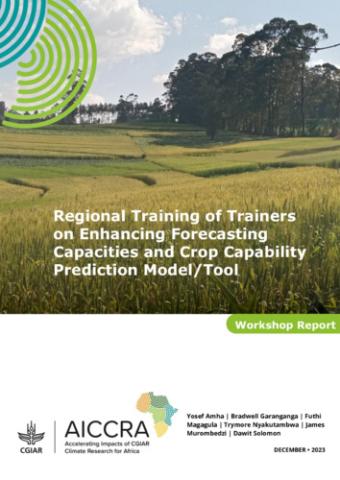Abstract
The detrimental impact of hydro-meteorological risks on agriculture frequently leads to food insecurity, particularly in Sub-Saharan Africa (SSA). Policy-makers should, therefore, adopt suitable policies that reduce the consequences of hydro-meteorological hazards on communities and economies. Moreover, there is an urgent need for timely and targeted climate-related knowledge, information, and solutions to help decision-makers prevent climate-related losses and maximize benefits. In this regard, regional partners commissioned a series of studies to develop a crop capacity prediction model/tool that would maximize agricultural productivity while limiting the effects of hydro-meteorological hazards on the food chain.
Based on the forecasted climatic evidence, this tool can assist policymakers and user communities in determining the most up-to-date crop capability. However, for this instrument to be fully operationalized and have the most significant possible impact, roving training of trainers (ToT) workshops for agricultural crop yield prediction users, seasonal climate forecast (SCF) providers, researchers, and academics are required. Since July 2022, three subsequent ToT workshops have been held in Harare-Zimbabwe, Maputo-Mozambique and Lusaka, Zambia. The Regional ToT workshop, held in Johannesburg, South Africa, from 21 to 24 November 2023, was the fourth such event. Around 30 experts from the SADC's Ministries/Departments of Agriculture, Meteorology, and Academia attended this workshop.
The ToT workshop covered a wide range of topics, such as providing a conceptual framework for the Climate Agriculture Modelling and Decision Tool (CAMDT)–Decision Support System for Agrotechnology Transfer (DSSAT) platform; the significance of SCF; a hands-on exercise in data management (quality control and missing values, as well as a specific template/format); data acquisition; model descriptions (assumptions and uncertainties); and model analysis (simulation and validation).
Given the critical significance of agriculture in the area, participants called for the full adoption of the SFC-driven crop capability prediction model and its early deployment for significant economic savings. According to the participants' feedback, the model and its outputs were successfully communicated, resulting in proficiency with the tool for future applications. They also commend the relevance of the training and a user manual. However, participants preferred more straightforward program-assisted software so that people with limited computer experience could run the model for immediate usage and application. They also suggested further improvement on the model to incorporate local conditions and critical cultivars such as potatoes and legumes.
For this capacity-building initiative to be successful and have a long-term impact, it must have the full support of relevant national and regional organizations, projects, and governments. More resources are also needed to ensure the continued improvement of the models and the transfer of skills within SADC and beyond.

